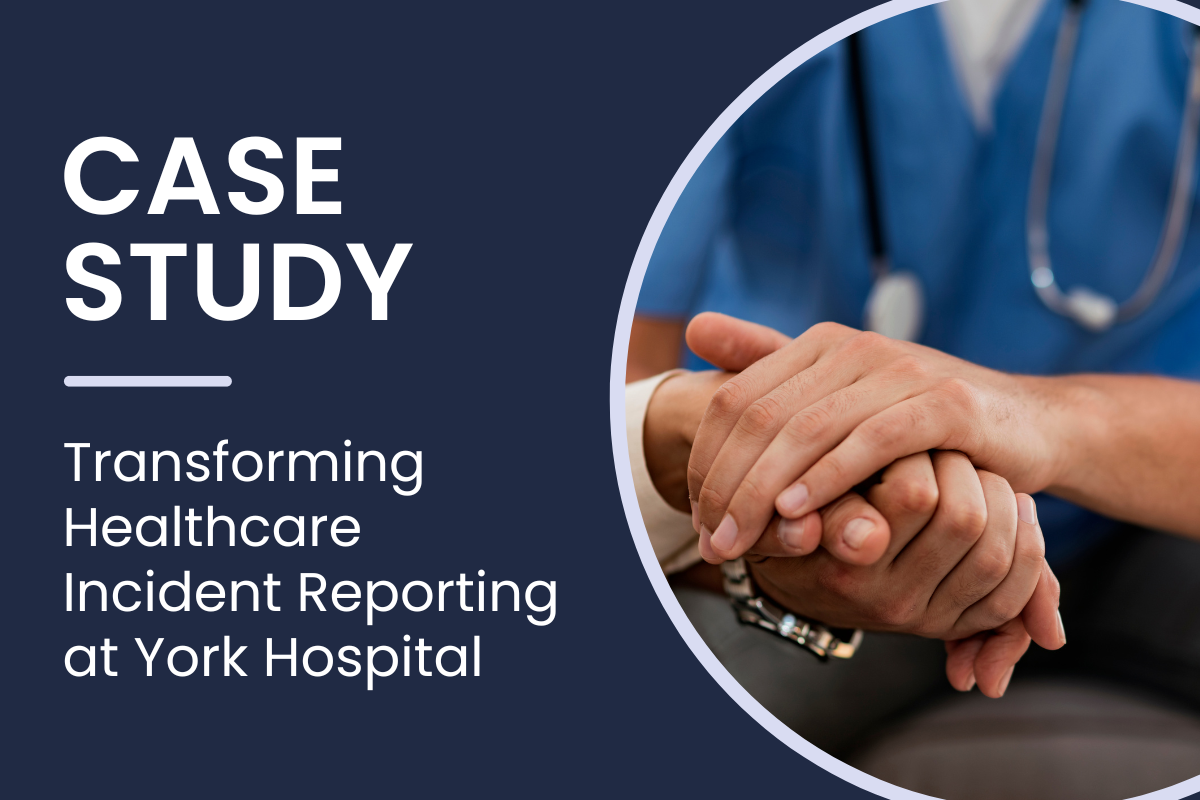How Incident Reporting Software Can Bridge Safety Perception Gaps
Consider a scenario in a hospital where management believes their emergency protocols are well understood and carefully followed by all staff. Yet,...

Leapfrog safety scores serve as a key metric in determining the safety performance of a hospital. Healthcare organizations can improve Leapfrog safety scores by implementing several strategies aimed at improving patient safety.
The Leapfrog Hospital Safety Grade is a measurement of hospital safety performance developed by The Leapfrog Group, a national nonprofit organization that aims to improve healthcare quality and safety in the United States. These scores provide a comprehensive assessment of a hospital’s ability to protect patients from preventable harm and medical errors.
The scoring system evaluates several aspects of patient safety, including:
Leapfrog safety scores are calculated using a standardized methodology that incorporates data from various sources, including voluntary hospital surveys, publicly available quality measures, and performance metrics reported to regulatory agencies. The scores are then publicly reported to provide transparency and enable patients to make informed decisions about where to seek care.
For hospitals, Leapfrog safety scores serve as a valuable benchmarking tool to identify areas for improvement, prioritize patient safety initiatives, and demonstrate their commitment to delivering high-quality, safe healthcare services. By striving to achieve higher safety scores, hospitals can enhance patient trust, reduce medical errors, and ultimately improve outcomes for those under their care.
The healthcare industry is facing significant workforce challenges, with approximately 800,000 registered nurses expected to leave nursing by 2027 and a projected shortage of up to 124,000 physicians by 2034. These shortages make it increasingly challenging for inexperienced staff to work alongside seasoned professionals while simultaneously increasing the workloads of new clinicians.
To close this experience gap, investing in comprehensive training programs is essential to ensure that all members of the healthcare team, from clinicians to support staff, are proficient and feel confident in patient safety protocols and best practices.
These programs should cover a wide range of topics, including medication safety, infection control, communication techniques, and incident management. By providing ongoing education sessions and regular updates on safety guidelines, healthcare organizations can significantly enhance staff adherence to protocols and improve overall performance.
Moreover, training programs must be tailored to meet the specific needs and responsibilities of different roles within the healthcare setting. Clinicians, for example, may require specialized training on medication administration techniques and medication error prevention strategies, while support staff may focus on environmental safety measures and patient communication skills.
By prioritizing staff training and education, healthcare organizations foster a culture of safety and improvement, empowering employees to prioritize patient safety at every stage of care delivery. This proactive approach not only reduces the likelihood of errors and adverse events but also enhances the overall quality of care and patient outcomes.
Emphasizing rigorous infection control practices is key to ensuring the safety of patients, healthcare employees, and visitors within facilities. This involves a multifaceted approach that includes stringent adherence to hand hygiene compliance, thorough environmental cleaning protocols, and strict adherence to isolation precautions.
Hand hygiene compliance is fundamental in preventing the spread of infections. Healthcare workers must consistently follow proper hand hygiene practices, including regular handwashing with soap and water or using alcohol-based hand sanitizers.
It has been shown proper infection control measures including handwashing can prevent healthcare-associated infections by 70%. Regular education and training programs can reinforce the importance of hand hygiene and promote compliance among staff members.
Regular and thorough environmental cleaning of patient rooms, equipment, and common areas is crucial to eliminate infection transmission sources. Using effective cleaning agents and following standardized procedures significantly reduces the risk of healthcare-associated infections.
Additionally, adherence to isolation precautions, including isolating patients with known or suspected infections and wearing appropriate PPE, is essential to prevent the spread of contagious diseases within healthcare settings.
Tools such as digital rounding software and automated checklists can help make these processes more streamlined and efficient, and can help ensure that the environment of care remains safe.
Strengthening communication channels among healthcare teams is fundamental to improving Leapfrog safety scores and ensuring seamless coordination throughout the care delivery process.
Failures in communication and teamwork have been identified as contributing factors in approximately 68% of adverse events.
Therefore, clear and standardized communication protocols play a vital role in promoting collaboration and reducing the risk of errors. Implementing structured handoff procedures during shift changes enables healthcare providers to exchange critical patient information accurately and efficiently, ensuring continuity of care and preventing potential communication gaps.
In addition to structured communication protocols, safety huddles play a crucial role in promoting a culture of safety within healthcare organizations. Safety huddles, often conducted at the beginning of shifts or during key transition points, provide a forum for team members to discuss potential safety concerns, share relevant information, and proactively identify and address any emerging issues.
By encouraging real-time communication and collective problem-solving, safety huddles empower healthcare teams to stay vigilant, mitigate risks, and prioritize patient safety.

Of adverse drug events, 20% are due to medication administration errors, which can lead to longer hospital stays, worsened patient outcomes, and even death.
To enhance medication safety practices, hospitals should implement stringent protocols such as electronic prescribing systems, barcode verification, and medication reconciliation processes. Taking these measures, along with conducting regular audits and reviews, help identify risks and ensure adherence to safety standards.
Barcode Medication Administration (BCMA) systems play a vital role in this process by verifying patient identity, medication details, and dosage accuracy during administration. However, scanning, or labeling errors in BCMA systems can lead to workarounds, posing potential risks to patient safety. Such errors, including unreadable or missing barcodes, signal the need for improved staff training, device configuration, and system reliability.
This concern is underscored by ERCI, an independent non-profit organization, listing workarounds with BCMA systems as one of the top patient safety concerns for 2024. Addressing these issues is crucial for minimizing medication errors and safeguarding patient well-being.
Establishing an effective incident management system is crucial for healthcare organizations to proactively address adverse events and near-misses, and prevent future harm.
By encouraging timely reporting and thorough investigation of incidents, organizations can identify root causes and implement targeted interventions to mitigate risks. Additionally, incident reporting fosters a culture of transparency and accountability, where staff members feel empowered to speak up about safety concerns without fear of retribution.
Furthermore, incident reporting plays a pivotal role in fostering a culture of improvement within healthcare organizations. By valuing and prioritizing the reporting of adverse events or near-misses, organizations signal their dedication to learning from mistakes and making meaningful changes to prevent future occurrences.
This proactive approach not only enhances patient safety but also is an effective step in improving Leapfrog safety scores.
Healthcare organizations can optimize patient safety by leveraging advanced technology solutions such as electronic health records (EHRs), clinical decision support systems, patient monitoring devices, and patient rounding tools.
EHRs streamline the documentation process and provide healthcare professionals with comprehensive patient information, facilitating informed decision-making and continuity of care. Clinical decision support systems integrate evidence-based guidelines and algorithms into the workflow, offering real-time recommendations and alerts to healthcare providers, thus reducing the risk of medical errors and adverse events.
Patient monitoring devices play a crucial role in continuously monitoring vital signs and patient parameters, enabling early detection of flawed conditions and prompt intervention. These devices provide clinicians with timely data, allowing for proactive management and prevention of adverse events.
Additionally, patient rounding tools facilitate structured patient assessments and enable healthcare teams to conduct regular rounds efficiently. These tools help ensure that patient needs are promptly addressed, medication regimens are followed accurately, and any potential safety concerns are identified and addressed promptly.
Encouraging partnerships with patients and their families is essential in healthcare, as it recognizes their vital role in the care process. By involving them in safety initiatives and care planning processes, healthcare providers not only empower patients but also benefit from their unique insights and perspectives. Open dialogue facilitates effective communication, allowing patients and families to express their concerns, ask questions, and actively participate in decision-making regarding their care.
Moreover, providing educational resources ensures that patients and their families are well-informed about their condition(s) and treatment options. This knowledge equips them to make informed decisions, adhere to prescribed treatments, and recognize potential warning signs or complications. Additionally, collecting feedback from patients and families demonstrates a commitment to continuous improvement and patient-centered care.
Research has shown that enhanced patient engagement can lead to significant benefits, including reduced readmission rates by up to 14%.
This reduction in readmissions not only improves patient outcomes but also mitigates healthcare costs associated with complications and extended hospital stays. By actively involving patients and families in their care, healthcare organizations can improve patient satisfaction, enhance safety outcomes, and ultimately achieve higher Leapfrog safety scores.
Learn how Performance Health Partners’ incident management system can help your organization improve its Leapfrog safety score. Click here to get started.

Consider a scenario in a hospital where management believes their emergency protocols are well understood and carefully followed by all staff. Yet,...

Prioritizing patient experience is vital for enhancing outcomes and offers multifaceted benefits for healthcare institutions. This strategic focus...

In a bold move to redefine healthcare incident reporting, York Hospital partnered with Performance Health Partners (PHP), transforming their approach...